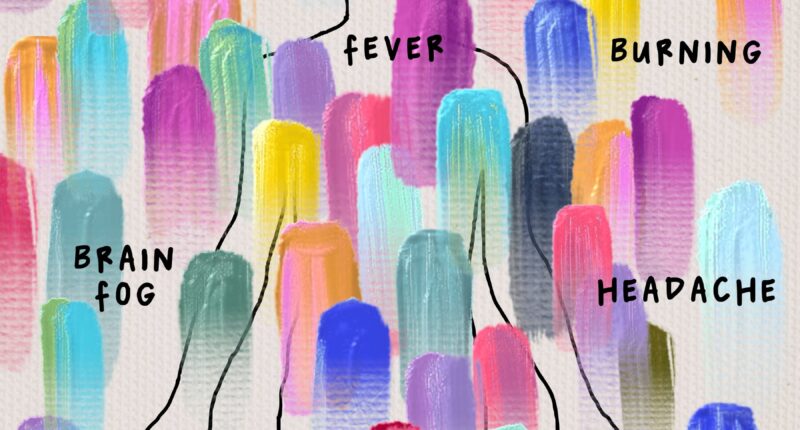Every morning, I wake up in my Brooklyn apartment, and for two seconds, I can remember the old me. The me without pain, the me with energy, the me who could do whatever she wanted.
Then I’m shoved back into my new reality. As I fully come into consciousness, I feel dizzy, faint and nauseated. Pain pulses throughout my body, and my limbs feel simultaneously as heavy as concrete and weak as jelly. It feels as if a machine were squeezing my skull, and extreme exhaustion overtakes me.
These sensations have been a daily occurrence, with few exceptions, for the past three years and nine months. In the morning my boyfriend will be the one making coffee for us. He will run all of our errands. He will cook and clean. He now does all the things I used to do, the things I can’t do anymore.
I live with what’s known as long Covid, an illness that has reshaped my life.
I’ve come to realize that “long Covid” is a deceptive term for a condition that can trigger a diverse swarm of debilitating symptoms with no end in sight. What I’ve experienced is in no way just a lingering cough or a few weeks of fatigue after an acute Covid infection.
I first got Covid in March 2020, just as New York City was going into lockdown. My case was mild. I was not hospitalized. Like many who got sick in those early days, I experienced what felt like a bad flu.

My doctors were confused when I wanted them to be alarmed. After many tests returned inconclusive results, they told me that I was probably just stressed and should take a break from work. Or I should try to push through and exercise. Or maybe I should start anti-anxiety meds.
Still, my symptoms persisted. In December 2021, I got Covid again. Excruciating nerve pain
began to radiate up and down my side. I visited more doctors and took more tests without finding any answers. I tried more than a dozen medications, injections and physical therapies, but this new pain never went away.

Despite getting my Covid boosters on schedule, being careful about potential exposure and wearing a mask in crowded spaces like the subway, in November 2022, I got Covid a third time. My symptoms became even worse, even more intense and entirely debilitating. Unrelenting chest tightness and tachycardia, dizziness while being upright, frequent nausea and headaches, systemic reactions to most foods, tinnitus, severe insomnia, a persistent feeling of being poisoned, blurry and double vision and exhaustion that would land me in bed with the lights off for days at a time.
Since “long Covid” is an umbrella term, definitions of which include people as debilitated as I am and people who have lingering fatigue or cough, it’s unclear how many people continue to be as sick as I have been. Recent research suggests that long Covid isn’t just one medical phenomenon but a condition with multiple subsets and over 200 recorded symptoms, including some that could be causing damage to multiple parts of the body at once.
I’m not a medical expert, but I’ve had to become one to make sense of my new reality. At work, I’m a graphic designer who creates data visualizations. I live and breathe data; it’s the filter I have to understand the world around me. My approach to data centers on its human qualities, reconnecting numbers to what they stand for: our imperfect and messy lives.
I thought that if I collected enough data, I would eventually figure out what was going wrong. But no matter how much data I collected or how many correlations I tried to draw, answers eluded me. Still, I couldn’t stop tracking. My spreadsheet was the only thing I could control in a life I no longer recognized.
Long Covid is a physical affliction, but chronic illness, stretching over months and years, has a way of picking apart your mind and breaking your heart. It is a constant deluge of pain that slowly strips you of everything you used to be by taking away everything you used to do — daily exercise, going out more nights than not, seeing friends, attending concerts, traveling the world and, eventually, laughter, smiles and the ability to imagine a future without harsh physical limits.
Even if my body, from the outside, resembles the old me, long Covid has rewritten my core personhood on a cellular level. I have been able to push myself to work at my desk most days (my job often feels like the only piece left of my old self), but I am never symptom-free, and I can see how this confuses people. This paradox is part of what makes treating this invisible illness, as researchers are starting to understand, so complex.
“The reason that patients are being minimized for so long is because it’s very, very clear that complex chronic illness doesn’t fit in this neat package of ‘Here’s an X-ray. You got a broken tibia,’” said David Putrino, the director of Mount Sinai’s center for complex chronic illness, who has been working with patients with long Covid since early in the pandemic.“What we are finally proving, though, is that categorically, stuff is going wrong in the bodies of these people.” As he has gained more experience with the condition, he’s stopped believing in the possibility of finding a single medical mechanism that would explain the full range of long Covid symptoms. “It doesn’t make sense to look for a single biomarker, given what these infection-triggered illnesses are doing to the body,” he said.






